For subwoofers, the acoustic center might be located — outside the enclosure — about one foot in front the loudspeaker.
"The acoustic center represents the point from which
the far‑field waves emanate — including their phase —
when projected back to the source."
— John Vanderkooy —
BEng, PhD (McMaster) – Distinguished Professor Emeritus
Audio Research Group, University of Waterloo (CA)
This point, acoustically, seems to — act — as the center of the loudspeaker at lower frequencies. The locus of an equivalent point source that yields the same far‑field
pressure in magnitude and phase. And when left unaccounted for, prevents one from reconciling field measurements and listening tests with theory and prediction methods.
Origin Story
A recent Facebook post about subwoofer polarity being the same on opposite sides of a sealed or front‑vented enclosure. Opened up a whole can of worms on whether or not such subwoofers are genuinely omni‑directional and exhibit the same phase response on opposite sides. Where a concise response to the significant feedback could no longer be consolidated into a few brief replies in the post's comments section. Hence this article.
I deliberately have been avoiding this discussion for years. Because I have come to consider it the most controversial topic in our field. Even worse than the alleged "cylindrical" waves expected of line arrays. Which I have addressed in another article.
I suspect the controversy stems from the fact that any violation of causality (cause and effect) makes people feel uncomfortable. For certain subwoofers, how can the acoustic center be offset from the motor. And miraculously "hover" outside, in front of the enclosure — and — act as the point where phase, that is, time, appears to emanate from?
I first learned about the low‑frequency acoustic center concept when I stumbled upon a seminal AES paper "The Low‑Frequency Acoustic Centre: Measurement, Theory and Application" by John Vanderkooy, professor at the University of Waterloo in Canada.
In his paper, Vanderkooy provides exhaustive evidence, complete with theory, analytic proof, modeling, and field measurements, all of which supported my own — personal — observations.
The research conducted under the leadership by Vanderkooy, prompted others to publish additional papers with more supporting evidence which I will list below.
Do I believe the low‑frequency acoustic center concept to be true. I suppose the jury is still out on this. Does it best explain my own — personal — observations of ambiguous discrepancies subject to interpretation? Yes!
However, I can always be persuaded otherwise. But, until more compelling evidence is presented that disproves the low‑frequency acoustic center concept, I feel it is the most plausible explanation so far.
Disclaimer
The low‑frequency acoustic center concept considers sealed and front‑vented enclosures. It does not apply to loudspeakers that have a purely di‑polar or cardioid‑like polar pattern at low frequencies. Any loudspeaker that essentially has a null in its polar response cannot conform to the acoustic center concept.
The phenomenon is expected to manifest itself for frequencies equal or less than the sound speed divided by twice the source size. Which — in the case of subwoofers — nearly always considers 100 Hz and lower.
Omni-directivity
When a loudspeaker is reproducing sound with a wavelength considerably larger than the size of its enclosure, we all know that it should be essentially omni‑directional and send out sound waves spherically. Bearing in mind that the definition for coverage angle, which states a 6 dB drop in level at the edge of coverage — when it comes to rating omni‑directivity for subwoofers — is one of the loosest standards in our industry.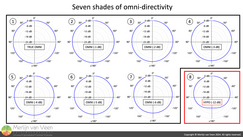 Figure 1Figure 1 shows at least seven shades of omni-directivity. Ranging from a perfect true omni‑directional pattern, with no angular attenuation it the back (180° off axis), to a pattern that is at most 6 dB down in the back (180° off axis).
Figure 1Figure 1 shows at least seven shades of omni-directivity. Ranging from a perfect true omni‑directional pattern, with no angular attenuation it the back (180° off axis), to a pattern that is at most 6 dB down in the back (180° off axis).
Where according to the letter of the law, all of them classify as omni‑directional. A pattern does not classify for the obscure hypo‑cardioid (also know as subcardioid) until level in the back (180° off axis) has dropped by 12 dB or more.
Sound fields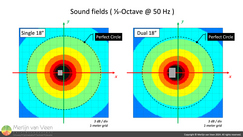 Figure 2Figure 2 shows modeled sound fields for a single 18" vented subwoofer and a dual 18" vented subwoofer. Where the contours (that separate the colors) denote positions of equal loudness.
Figure 2Figure 2 shows modeled sound fields for a single 18" vented subwoofer and a dual 18" vented subwoofer. Where the contours (that separate the colors) denote positions of equal loudness.
Reminiscent of a terrain map with elevation contours, where each contour denotes the path along which altitude remains the same.
Notice that with increasing distance to the loudspeakers (larger radii), the contours approximate perfect circles, that is, omni‑directivity. And how the origin of those concentric circles is offset with respect to the loudspeakers themselves.
Field measurements
When one attempts to verify omni‑directivity in the field. For example, with microphones on opposite sides, equidistant to a known reference point. For subwoofers, choosing the — correct — reference point is crucial.
"If you don’t know the answer before you start to measure,
how do you know you are getting a good measurement?"
- Ivan Beaver -
Chief Engineer at Danley Sound Labs
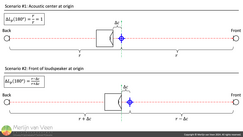 Figure 3Figure 3 compares two scenarios that assume the low‑frequency center concept is plausible and that the subwoofer turns out to be omni‑directional for frequencies whose wavelengths are considerably larger than the loudspeaker.
Figure 3Figure 3 compares two scenarios that assume the low‑frequency center concept is plausible and that the subwoofer turns out to be omni‑directional for frequencies whose wavelengths are considerably larger than the loudspeaker.
In the first scenario both microphones are equidistant to the acoustic center. In which case one would expect matching levels on either side.
Whereas in scenario #2, both microphones are equidistant to the front of the loudspeaker. In which case one would expect more level in the front and less level in the back. Since the — acoustic center itself — is now closer to the front microphone, and therefore louder in the front. And more distant to the rear microphone, and therefore less loud in the back.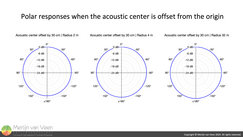 Figure 4Figure 4 shows polar responses for scenario #2 at different radii with respect to the — front of the loudspeaker — as opposed to its acoustic center. Where the acoustic center is nevertheless located 30 cm (roughly one foot) in front of the enclosure.
Figure 4Figure 4 shows polar responses for scenario #2 at different radii with respect to the — front of the loudspeaker — as opposed to its acoustic center. Where the acoustic center is nevertheless located 30 cm (roughly one foot) in front of the enclosure.
Notice that the polar responses change with observation distance. This poses two serious contradictions:
- It violates the idea behind polar responses whose — shape — should not change with increasing distance. Which is why polar responses should be captured in the far field where their shape no longer changes with increasing distance.
- As an audio professional I appear to be unable to independently verify and reconcile if the subwoofer is almost perfectly omni‑directional
To resolve the first contradiction, maybe we should increase the measurement distance to at least one wavelength (a well‑known rule of thumb for estimating the onset of the far field) for the frequencies of interest. Which could mean as little as 11 meters (36 feet) if 31 Hz is one of them.
According to both Vanderkooy as well as Don Keele this is not necessary for subwoofer frequencies.
"...it appears that the observation distance can actually be much closer than a wavelength, a sufficient distance being several times the size of the source."
— John Vanderkooy —
BEng, PhD (McMaster) – Distinguished Professor Emeritus
Audio Research Group, University of Waterloo (CA)
So in practice, several meters should already suffice. Whereas for bullet point #2, let us look at some modeled measurement results.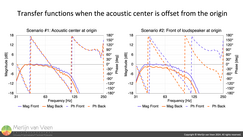 Figure 5Figure 5 shows transfer functions for both scenarios. In the first scenario, as was forecast, the subwoofer comes very close to being perfectly omni‑directional. Most notably with decreasing frequency.
Figure 5Figure 5 shows transfer functions for both scenarios. In the first scenario, as was forecast, the subwoofer comes very close to being perfectly omni‑directional. Most notably with decreasing frequency.
Also notice the perfectly matched phase traces on either side of the loudspeaker. So clearly polarity remains the same on both sides. Otherwise one of the phase traces would exhibit a 180° offset for — all — frequencies.
Whereas the — same — subwoofer measured in accordance with scenario #2. "Appears" to be louder in the front compared to the back (180° off axis). And equally misleading, the phase traces no longer seem to be the same. Which is obvious when one realizes that the acoustic center is now closer to, and therefore leading at, the front microphone. While being more distant to, and therefore lagging at, the rear microphone.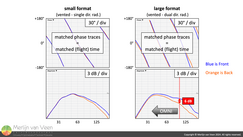 Figure 6Figure 6 shows — actual field measurements — made at a former airforce base, when I was still an independent contractor. It considers a single 19" and a dual 19" subwoofer. Measurements were made on opposite sides, equidistant to their acoustics centers.
Figure 6Figure 6 shows — actual field measurements — made at a former airforce base, when I was still an independent contractor. It considers a single 19" and a dual 19" subwoofer. Measurements were made on opposite sides, equidistant to their acoustics centers.
Once more one can clearly see the polar reponses tend to omni‑directivity with decreasing frequency. And as far as the "loose" definition of coverage angle is concered (for subwoofers), both loudspeakers — within their pass bands — clasify as omni‑directional.
One can also once more see that no polarities are reverted.
References
- "The Low-Frequency Acoustic Center: Measurement, Theory, and Application"
by John Vanderkooy
AES Convention: 128 Paper Number:7992, May 2010 - "Limitations of Point-Source Sub-Woofer Array Models for Live Sound"
by Thompson, Ambrose; Luzarraga Iturrioz, Josebaitor; Anthony, Phil
AES Convention: 133 Paper Number: 8718, Oct 2012 - "Effects of Acoustic Center Position in Subwoofers"
by Di Cola, Mario; Martignon, Paolo; van Veen, Merlijn
AES Convention: 143 Paper Number: 376, Oct 2017 - "On the low-frequency acoustic center"
by Samuel D. Bellows, and Timothy W. Leishman
J. Acoust. Soc. Am., Jun 2023 - "Low-Frequency Loudspeaker Assessment by Nearfield Sound-Pressure Measurement"
by Keele, Jr., D. B. (Don)
AES Journal Article 1974
